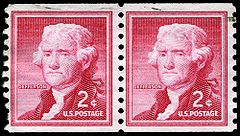
This 2-cent coil stamp of the US 1954 Liberty series
was used heavily throughout the 1950s and 60s.
A coil stamp is a type of postage stamp sold in strips one stamp
wide. The name derives from the usual handling of long strips, which is to
coil them into rolls, in a manner reminiscent of adhesive tape rolls. A large
percentage of modern stamps are sold in coil form, since they are more
amenable to mechanized handling in large quantities than either sheet stamps
or booklet stamps.
Coil stamps first appeared at the beginning of the 20th century. In the
United States for instance, vending machines companies began to experiment
with the automated dispensing of stamps. Early efforts to break sheets into
strips manually did not work well, since they were prone to tearing and
jamming, and soon the companies began to request imperforate sheets from the
post office, cutting those into strips and punching holes of various shapes
between each stamp. A variety of these "private coils" is known, some quite
rare. The first US government-produced coils appeared in 1908, produced by
pasting together enough imperforate sheets to make rolls of 500 or 1,000
stamps, cutting them into strips and perforating between. In the UK, coil
stamps first appered in 1907, to supply newly installed stamp vending
machines. As these were cut from complete sheets, they are perforated on all
four sides. As each stamp was worth either a half or one old penny and 240
pence made up one pound sterling, the coils were in rolls of 960 or 480 each.

A vertical coil pair with a joint line, US 1917
Later a rotary press was adopted, which eliminated the pasting stage. The
cylindrical plate used on a rotary press has a seam where ink tends to
accumulate, resulting in joint line pairs.
The perforations of coil stamps are usually found along the right and left
sides ("vertical perf"), but they have also been produced with perforations
along the top and bottom ("horizontal perf").
A recent innovation enabled by self-adhesive technology is the linerless
coil stamp. While most self-adhesives have backing paper, linerless coils
are like a roll of adhesive tape. Such rolls tend to be enormous, with
thousands of stamps, and tend to be used only by large mailing operations.
While in most countries coil production is restricted to the workaday
stamps used in large quantities, Sweden has produced coil versions of most of
their stamps



























































